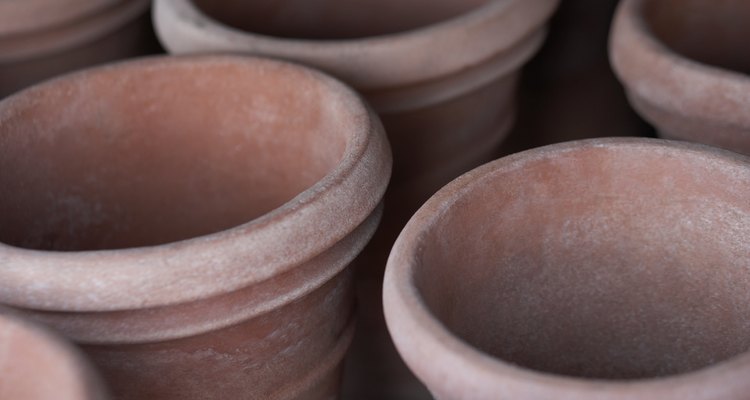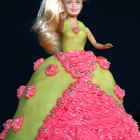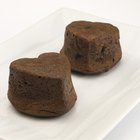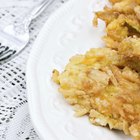
Jack Hollingsworth/Photodisc/Getty Images
Terra cotta flower pots make serviceable baking vessels for small breads and tea cakes, provided you use unglazed, undecorated pots and season them properly. Cornbread studded with chili peppers looks at home in the rustic pots, as does hearty zucchini-walnut bread. For more experienced bakers, individual yeasted breads can also be cooked as mini-loaves in the pots. After the treat is done, the pots themselves become a secondary gift, useful for growing flowers and herbs.
Pot Preparation
Wash the terra cotta pots in hot, soapy water. Wipe them dry and set them upright to dry further.
Heavily grease the inside and outside of the terra cotta pots and set them on a baking sheet. Bake the pots in a 300-degree Fahrenheit oven for 30 minutes before removing the pots.
Let the pots cool. Then regrease and re-bake them at the same temperature for another 30 minutes. Allow them to cool a second time.
Cut circles of aluminum foil sized to fit the bottom of the pot. Grease both sides of the circles and set them at the bottom of the pots.
Snip out rectangles of foil sized to the inner sides of the pots. Grease both sides of the rectangles and press them into the interior walls of the pots. The inner pots should now be completely covered in foil, with the foil side that is facing outward greased.
Quick Breads and Tea Cakes
Set oven to 400 F.
Mix together dry ingredients in the larger bowl. Whisk together wet ingredients in the smaller one. Make a well in the dry ingredients and add the wet ingredients, stirring until the mix is well-incorporated and lump-free. Gently blend in any additional ingredients.
Spoon batter into the terra cotta pots so that each is about two-thirds full.
Put the pots on a baking sheet and set the baking sheet in the oven. Set the timer for 15 minutes. The baking may take 20 minutes or longer, depending on the density of the cake or bread.
Remove the pots when a toothpick inserted in the center comes out clean.
Take the pots off the baking sheet and set them on wire racks to cool.
Yeast Breads
Set oven to 400 F.
Mix yeast with warm water and sugar, according to your recipe.
Incorporate the yeast mixture into the other ingredients until it forms a dough.
Knead the dough on a floured surface until the dough turns smooth.
Leave the dough to rise in an oiled bowl until it doubles, then punch the dough down.
Divide the dough equally among the seasoned, foiled and greased flower pots.
Let the dough double a second time, this time in their individual pots.
Put the pots on a baking sheet and set them in the preheated oven.
Set the timer for 25 minutes. The baking may take 30 minutes or longer.
Remove the pots when the crusts are golden and sound hollow when tapped.
Set the pots on wire racks to cool.
Related Articles

How Long Do You Bake Brownie Cupcakes ...

How to Adjust the Oven Temperature for ...

How to Cook Brownie Cupcakes Without ...

How to Bake Bread in a Clay Pot

Instructions for Baking Fruit Cake in ...

Can I Make a Cake Mix in a Ceramic Dish?

How to Make Cakes With Candy Baked ...

Can I Bake Cupcakes in Teacups?

How to Steam Cook a Cake

How to Make a Dome-Shaped Cake

Roshco Silicone Bakeware Instructions
Easy Pumpkin Roll Recipe

Directions for Baking Tortillas Into ...

How to Cook Cheesecake in a Cupcake Pan
How Long Do You Bake a Double Batch of ...

How to Keep Cupcake Wrappers From ...

How to Make a Guitar Out of Cupcakes

The Best Cake and Cupcake Tools and ...

What Is a Souffle Dish?

How to Cook Pumpkin Blossoms
References
- Sunset Gifts from Your Kitchen; Mary Jane Swanson and Cynthia Overbeck Bix
- Lasagna Gardening with Herbs; Patricia Lanza
- North Dakota State University Extension Service: Unusual Containers for Preparing Food Not Always Safe
Warnings
- Don't skip the step of lining the pots with aluminum foil or another protective, food-grade material. Some terra cotta pots may contain lead that would otherwise leach into the foods with which they come into direct contact.
- Take the precaution of a buying a few extra of the inexpensive pots. They may break during the seasoning or even the baking process.
Writer Bio
Ellen Douglas has written on food, gardening, education and the arts since 1992. Douglas has worked as a staff reporter for the Lakeville Journal newspaper group. Previously, she served as a communication specialist in the nonprofit field. She received her Bachelor of Arts from the University of Connecticut.
Photo Credits
Jack Hollingsworth/Photodisc/Getty Images